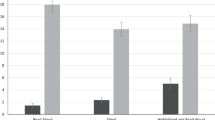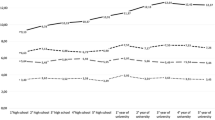Abstract
Print exposure is an important causal factor in reading development. Little is known, however, of the mechanisms through which print exposure exerts an effect onto reading. To address this gap, we examined the direct and indirect effects of print exposure on silent reading fluency among college students (n = 52). More specifically, we focused on phonetic decoding and sight word reading efficiency as potential mediators of the indirect effects of print exposure on silent reading fluency. Silent reading fluency was chosen as the outcome given that the natural reading experience occurs predominately in the silent mode. Results showed that the direct effect of print exposure on silent reading fluency was significant. Sight word reading efficiency partially mediated the indirect effect of print exposure on silent reading fluency. Phonetic decoding efficiency also partially mediated the indirect effect of print exposure on silent reading fluency, but only when followed by sight word reading efficiency to form a serial and joint mechanism (i.e., print exposure → phonetic decoding → sight word reading → silent reading fluency). Present findings highlight two mechanisms through which print exposure exerts an effect onto silent reading fluency, both of which involve sight word reading efficiency.

Similar content being viewed by others
References
Acheson, D. J., Wells, J. B., & MacDonald, M. C. (2008). New and updated tests of print exposure and reading abilities in college students. Behavioral Research Methods, 40, 278–289.
Anderson, R. C., Wilson, P. T., & Fielding, L. G. (1988). Growth in reading and how children spend their time outside of school. Reading Research Quarterly, 23, 285–303.
Bräten, I., Lie, A., Andreassen, R., & Olaussen, B. S. (1999). Leisure time reading and orthographic processes in word recognition among Norwegian third-and fourth-grade students. Reading and Writing: An Interdisciplinary Journal, 11, 65–88.
Chateau, D., & Jared, D. (2000). Exposure to print and word recognition processes. Memory & Cognition, 28, 143–153.
Cunningham, A. E., & Stanovich, K. E. (1990). Assessing print exposure and orthographic processing skill in children: A quick measure of reading experience. Journal of Educational Psychology, 82, 733–740.
Cunningham, A. E., & Stanovich, K. E. (1993). Children’s literacy environments and early word recognition subskills. Reading and Writing, 5, 193–204.
Cunningham, A. E., & Stanovich, K. E. (1997). Early reading acquisition and its relation to reading experience and ability 10 years later. Developmental Psychology, 33, 934–945.
Ecalle, J., & Magnan, A. (2008). Relations between print exposure and literacy skills: New evidence from grade 1–5. British Journal of Developmental Psychology, 26, 525–544.
Echols, L. D., West, R. F., Stanovich, K. E., & Zehr, K. S. (1996). Using children’s literacy activities to predict growth in verbal cognitive skills: A longitudinal investigation. Journal of Educational Psychology, 88, 296–304.
Ehri, L. C. (1995). Phases of development in learning to read words by sight. Journal of Research in Reading, 18, 116–125.
Ehri, L. C. (1998). Grapheme–phoneme knowledge is essential for learning to read words in English. In J. Metsala & L. Ehri (Eds.), Word recognition in beginning reading (pp. 3–40). Hillsdale, NJ: Erlbaum.
Ehri, L. C. (2014). Orthographic mapping in the acquisition of sight word reading, spelling memory, and vocabulary learning. Scientific Studies of Reading, 18, 5–21.
Frith, U. (1985). Beneath the surface of developmental dyslexia. In K. Patterson, J. Marshall, & M. Coltheart (Eds.), Surface dyslexia (pp. 301–330). London: Erlbaum.
Gagliano, A., Cluffo, M., Ingrassia, M., Ghidoni, E., Angelini, D., Benedetto, L., et al. (2015). Silent reading fluency: Implications for the assessment of adults with developmental dyslexia. Journal of Clinical and Experimental Neuropsychology, 37, 972–980.
Grant, A., Wilson, A. M., & Gottardo, A. (2007). The role of print exposure in reading skills of postsecondary students with and without reading disabilities. Exceptionality Education Canada, 17, 175–194.
Gustafson, S. (2001). Cognitive abilities and print exposure in surface and phonological types of reading disability. Scientific Studies of Reading, 5, 351–375.
Harlaar, N., Dale, P. S., & Plomin, R. (2007). Reading exposure: A (largely) environmental risk factor with environmentally-mediated effects on reading performance in the primary school years. Journal of Child Psychology and Psychiatry, 48, 1192–1199.
Harlaar, N., Trzaskowski, M., Dale, P. S., & Plomin, R. (2014). Word reading fluency: Role of genome-wide single-nucleotide polymorphisms in developmental stability and correlations with print exposure. Child Development, 85, 1190–1205.
Hayes, A. F. (2012). PROCESS: A versatile computational tool for observed variable mediation, moderation, and conditional process modeling [White paper]. Retrieved from http://www.afhayes.com/public/process2012.pdf.
Jorm, A. F., & Share, D. L. (1983). Phonological recoding and reading acquisition. Applied Psycholinguistics, 4, 103–147.
Kirby, J. R., Parrila, R. K., & Pfeiffer, S. L. (2003). Naming speed and phonological awareness as predictors of reading development. Journal of Educational Psychology, 95, 453–464.
Kudo, M. F., Lussier, C. M., & Swanson, H. L. (2015). Reading disabilities in children: A selective meta-analysis of the cognitive literature. Research in Developmental Disabilities, 40, 51–62.
Landerl, K., & Wimmer, H. (2008). Development of word reading fluency and spelling in a consistent orthography: An 8-year follow-up. Journal of Educational Psychology, 100, 150–161.
Lowder, M. W., & Gordon, P. C. (2017). Print exposure modulates the effects of repetition priming during sentence reading. Psychonomic Bulletin & Review, 21, 1–8.
Mano, Q. R. (2016). Developing sensitivity to subword combinatorial orthographic regularity (SCORe): A two-process framework. Scientific Studies of Reading, 20, 231–247.
Mano, Q. R., & Osmon, D. C. (2008). Visuoperceptual-orthographic reading abilities: A confirmatory factor analysis study. Journal of Clinical and Experimental Neuropsychology, 30(4), 421–434.
Mano, Q. R., Williamson, B. J., Pae, H. K., & Osmon, D. C. (2016). Stroop interference associated with efficient reading fluency and prelexical orthographic processing. Journal of Clinical and Experimental Neuropsychology, 38, 275–283.
Martin-Chang, S. L., & Gould, O. N. (2008). Revisiting print exposure: Exploring differential links to vocabulary, comprehension and reading rate. Journal of Research in Reading, 31, 273–284.
McArthur, G., Castles, A., Kohnen, S., Larsen, L., Jones, K., Anandakumar, T., et al. (2015). Sight word and phonics training in children with dyslexia. Journal of Learning Disabilities, 48, 391–407.
McBride-Chang, C. (1996). Phonological processing skills and print exposure: Correlates of word reading in children ages 9 to 16. Reading & Writing Quarterly: Overcoming Learning Difficulties, 12, 385–400.
McGrew, K., Laforte, E., & Schrank, F. (2014). Technical Manual. Woodcock-Johnson IV. Rolling Meadows, IL: Riverside.
Mol, S. E., & Bus, A. G. (2011). To read or not to read: A meta-analysis of print exposure from infancy to early adulthood. Psychological Bulletin, 137, 267–296.
Montag, J. L., & MacDonald, M. C. (2015). Text exposure predicts spoken production of complex sentences in eight and twelve year old children and adults. Journal of Experimental Psychology: General, 144, 447–468.
Moore, M., & Gordon, P. C. (2015). Reading ability and print exposure: Item response theory analysis of author recognition test. Behavioral Research, 47, 1095–1109.
Nathan, R. G., & Stanovich, K. E. (1991). The causes and consequences of differences in reading fluency. Theory into Practice, 30, 176–184.
National Institute of Child Health and Human Development. (2000). Report of the National Reading Panel. Teaching children to read: An evidence-based assessment of the scientific research literature on reading and its implications for reading instruction (NIH Publication No. 00-4769). Washington, DC: U.S. Government Printing Office.
Norton, E. S., & Wolf, M. (2012). Rapid automatized naming (RAN) and reading fluency: Implications for understanding and treatment of reading disabilities. Annual Review of Psychology, 63, 427–452.
Oldfield, R. C. (1971). The assessment and analysis of handedness: The Edinburgh Inventory. Neuropsychologia, 9, 97–113.
Osana, H. P., Lacroix, G. L., Tucker, G. J., Idan, E., & Jabbour, G. W. (2007). The impact of print exposure quality and inference construction on syllogistic reasoning. Journal of Educational Psychology, 99, 888–902.
Patterson, K., Marshall, J., & Coltheart, M. (1985). Surface dyslexia. London: Erlbaum.
Payne, B. R., Gao, X., Noh, S. R., Anderson, C. J., & Stine-Morrow, E. A. (2012). The effects of print exposure on sentence processing and memory in older adults: Evidence for efficiency and reserve. Aging, Neuropsychology, and Cognition, 19, 122–149.
Pikulski, J. J., & Chard, D. J. (2005). Fluency: Bridge between decoding and reading comprehension. The Reading Teacher, 58, 510–519.
Reitsma, P. (1983). Printed word learning in beginning readers. Journal of Experimental Child Psychology, 36, 321–339.
Sears, C. R., Siakaluk, P. D., Chow, V. C., & Buchanan, L. (2008). Is there an effect of print exposure on the word frequency effect and the neighborhood size effect? Journal of Psycholinguistic Research, 37, 269–291.
Shahar-Yames, D., & Share, D. L. (2008). Spelling as a self-teaching mechanism in orthographic learning. Journal of Research in Reading, 31, 22–39.
Share, D. L. (1999). Phonological recoding and orthographic learning: A direct test of the self-teaching hypothesis. Journal of Experimental Child Psychology, 72, 95–129.
Share, D. L., & Stanovich, K. E. (1995). Cognitive processes in early reading development: A model of acquisition and individual differences. Issues in Education: Contributions from Educational Psychology, 1, 1–57.
Sparks, R. L., Patton, J., & Murdoch, A. (2014). Early reading success and its relationship to reading achievement and reading volume: Replication of ‘10 years later’. Reading and Writing, 27, 189–211.
Spear-Swerling, L., Brucker, P. O., & Alfano, M. P. (2010). Relationships between sixth-graders’ reading comprehension and two different measures of print exposure. Reading and Writing, 23, 73–96.
Stanovich, K. E. (1986). Matthew effects in reading: Some consequences of individual differences in the acquisition of literacy. Reading Research Quarterly, 21, 360–407.
Stanovich, K. E., & Cunningham, A. E. (1992). Studying the consequences of literacy within a literate society: The cognitive correlates of print exposure. Memory & Cognition, 20, 51–68.
Stanovich, K. E., & West, R. F. (1989). Exposure to print and orthographic processing. Reading Research Quarterly, 24, 402–433.
Swanson, H. L. (2012). Adults with reading disabilities: Converting a meta-analysis to practice. Journal of Learning Disabilities, 45, 17–30.
Therrien, W. J. (2004). Fluency and comprehension gains as a result of repeated reading: A meta-analysis. Remedial and Special Eduction, 25, 252–261.
Torgesen, J. K., Wagner, R. K., & Rashotte, C. A. (2012). Test of word reading efficiency-second edition. Austin, TX: Pro-Ed.
Author information
Authors and Affiliations
Corresponding author
Rights and permissions
About this article
Cite this article
Mano, Q.R., Guerin, J.M. Direct and indirect effects of print exposure on silent reading fluency. Read Writ 31, 483–502 (2018). https://doi.org/10.1007/s11145-017-9794-5
Published:
Issue Date:
DOI: https://doi.org/10.1007/s11145-017-9794-5




